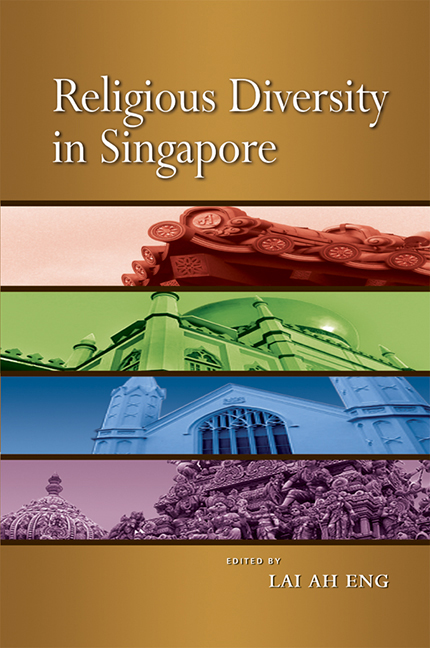Book contents
- Frontmatter
- Contents
- List of Figures and Tables
- List of Appendices
- FOREWORD
- PREFACE
- Acknowledgements
- The Contributors
- Abbreviations
- Glossary
- INTRODUCTION
- PART I The Landscape of Religious Diversity
- PART II Religion in Schools and Among the Young
- 13 From Moral Values to Citizenship Education: The Teaching of Religion in Singapore Schools
- 14 Religious Education as Locus of Curriculum: A Brief Inquiry into Madrasah Curriculum in Singapore
- 15 Mission Schools in Singapore: Religious Harmony, Social Identities, and the Negotiation of Evangelical Cultures
- 16 Religious Switching and Knowledge among Adolescents in Singapore
- PART III Religion in the Media
- PART IV Religious Organizations in Social Services
- PART V Interfaith Issues and Interaction
- Index
13 - From Moral Values to Citizenship Education: The Teaching of Religion in Singapore Schools
from PART II - Religion in Schools and Among the Young
Published online by Cambridge University Press: 21 October 2015
- Frontmatter
- Contents
- List of Figures and Tables
- List of Appendices
- FOREWORD
- PREFACE
- Acknowledgements
- The Contributors
- Abbreviations
- Glossary
- INTRODUCTION
- PART I The Landscape of Religious Diversity
- PART II Religion in Schools and Among the Young
- 13 From Moral Values to Citizenship Education: The Teaching of Religion in Singapore Schools
- 14 Religious Education as Locus of Curriculum: A Brief Inquiry into Madrasah Curriculum in Singapore
- 15 Mission Schools in Singapore: Religious Harmony, Social Identities, and the Negotiation of Evangelical Cultures
- 16 Religious Switching and Knowledge among Adolescents in Singapore
- PART III Religion in the Media
- PART IV Religious Organizations in Social Services
- PART V Interfaith Issues and Interaction
- Index
Summary
INTRODUCTION
To many people, “religion” is an emotive word. It is therefore not surprising that the teaching of religion in schools elicits strong responses from people. For example, Kazepides avers that religious beliefs do not and cannot aim at enriching and developing the human mind; instead they lead to people living “under an absolute, palpable tyranny” (1983, p. 264). On the other hand, policymakers in England and Wales, in making religious education compulsory in state schools, see it as morally educative and socially beneficial for students (Hand and White 2004). Given the fact that Singapore is a multi-religious society and that some form of religious teaching exists in the schools, it is intriguing and pertinent to explore the teaching of religion in Singapore schools. This chapter discusses the attempts by the government to teach religious beliefs and practices in Singapore schools for the purpose of inculcating moral values and promoting citizenship education. It points out the shortcomings of the current approach used in the teaching of religion in schools, and explores Spiritual Education (SE) as a possible alternative.
THE CONTEXT
It has been argued that the Singapore government has adopted a secular stance towards religious institutions, and expects all religions to adjust to the state ideology (for example, see Ling 1987; Ackermann 1999). A number of researchers have also pointed out that religion is taught in Singapore schools with the aims of promoting moral values, social cohesion and national unity (for example, see Tan 1994; Chew 1998; Tan 2000; Tan and Chew 2004). Religious studies were formally introduced to all secondary schools as a compulsory subject known as Religious Knowledge (RK) in the 1980s.
To understand why RK was introduced in 1984, it is important to know the challenges and needs during that period. The bold measure to introduce RK was due to both push and pull factors. Under the “push” factors, there was an expressed concern that the young in Singapore were susceptible to what was perceived to be negative Western moral values. Government leaders at that time believed that industrialization, urbanization and modernization had led to increasing social problems and the abandonment of traditional values (Gopinathan 1980; Tan 2000).
- Type
- Chapter
- Information
- Religious Diversity in Singapore , pp. 321 - 341Publisher: ISEAS–Yusof Ishak InstitutePrint publication year: 2008

